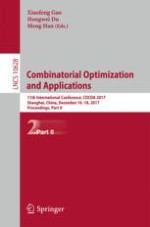2017 | OriginalPaper | Buchkapitel
Complexity and Online Algorithms for Minimum Skyline Coloring of Intervals
verfasst von : Thomas Erlebach, Fu-Hong Liu, Hsiang-Hsuan Liu, Mordechai Shalom, Prudence W. H. Wong, Shmuel Zaks
Erschienen in: Combinatorial Optimization and Applications
Aktivieren Sie unsere intelligente Suche, um passende Fachinhalte oder Patente zu finden.
Wählen Sie Textabschnitte aus um mit Künstlicher Intelligenz passenden Patente zu finden. powered by
Markieren Sie Textabschnitte, um KI-gestützt weitere passende Inhalte zu finden. powered by
